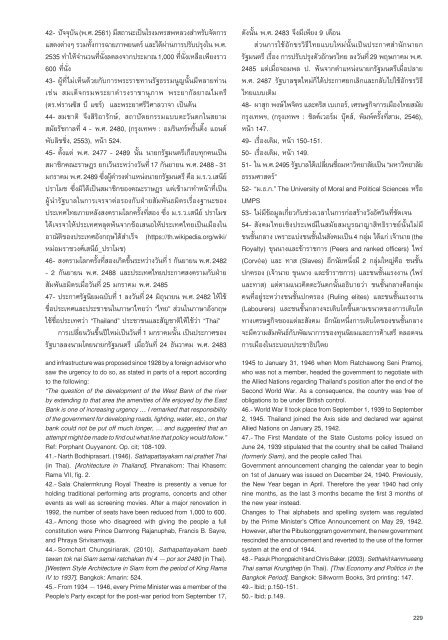บ้านเรือนถิ่นไทยในช่วงเจ็ดทศวรรษ 2489-2559
Create successful ePaper yourself
Turn your PDF publications into a flip-book with our unique Google optimized e-Paper software.
42- ปัจจุบัน (พ.ศ. 2561) มีสถานะเป็นโรงมหรสพหลวงสำหรับจัดการ<br />
แสดงต่างๆ รวมทั้งการฉายภาพยนตร์ และได้ผ่านการปรับปรุงใน พ.ศ.<br />
2535 ทำให้จำนวนที่นั่งลดลงจากประมาณ 1,000 ที่นั่งเหลือเพียงราว<br />
600 ที่นั่ง<br />
43- ผู้ที่ไม่เห็นด้วยกับการพระราชทานรัฐธรรมนูญนั้นมีหลายท่าน<br />
เช่น สมเด็จกรมพระยาดำรงราชานุภาพ พระยากัลยาณไมตรี<br />
(ดร.ฟรานซิส บี แซร์) และพระยาศรีวิศาลวาจา เป็นต้น<br />
44- สมชาติ จึงสิริอารักษ์, สถาปัตยกรรมแบบตะวันตกในสยาม<br />
สมัยรัชกาลที่ 4 - พ.ศ. 2480, (กรุงเทพฯ : อมรินทร์พริ้นติ้ง แอนด์<br />
พับลิชชิ่ง, 2553), หน้า 524.<br />
45- ตั้งแต่ พ.ศ. 2477 - <strong>2489</strong> นั้น นายกรัฐมนตรีเกือบทุกคนเป็น<br />
สมาชิกคณะราษฎร ยกเว้นระหว่างวันที่ 17 กันยายน พ.ศ. 2488 - 31<br />
มกราคม พ.ศ. <strong>2489</strong> ซึ่งผู้ดำรงตำแหน่งนายกรัฐมนตรี คือ ม.ร.ว.เสนีย์<br />
ปราโมช ซึ่งมิได้เป็นสมาชิกของคณะราษฎร แต่เข้ามาทำหน้าที่เป็น<br />
ผู้นำรัฐบาลในการเจรจาต่อรองกับฝ่ายสัมพันธมิตรเรื่องฐานะของ<br />
ประเทศไทยภายหลังสงครามโลกครั้งที่สอง ซึ่ง ม.ร.ว.เสนีย์ ปราโมช<br />
ได้เจรจาให้ประเทศหลุดพ้นจากข้อเสนอให้ประเทศไทยเป็นเมืองใน<br />
อาณัติของประเทศอังกฤษได้สำเร็จ (https://th.wikipedia.org/wiki/<br />
หม่อมราชวงศ์เสนีย์_ปราโมช)<br />
46- สงครามโลกครั้งที่สองเกิดขึ้นระหว่างวันที่ 1 กันยายน พ.ศ. 2482<br />
- 2 กันยายน พ.ศ. 2488 และประเทศไทยประกาศสงครามกับฝ่าย<br />
สัมพันธมิตรเมื่อวันที่ 25 มกราคม พ.ศ. 2485<br />
47- ประกาศรัฐนิยมฉบับที่ 1 ลงวันที่ 24 มิถุนายน พ.ศ. 2482 ให้ใช้<br />
ชื่อประเทศและประชาชนในภาษาไทยว่า “ไทย” ส่วนในภาษาอังกฤษ<br />
ใช้ชื่อประเทศว่า “Thailand” ประชาชนและสัญชาติให้ใช้ว่า “Thai”<br />
การเปลี่ยนวันขึ้นปีใหม่เป็นวันที่ 1 มกราคมนั้น เป็นประกาศของ<br />
รัฐบาลลงนามโดยนายกรัฐมนตรี เมื่อวันที่ 24 ธันวาคม พ.ศ. 2483<br />
and infrastructure was proposed since 1928 by a foreign advisor who<br />
saw the urgency to do so, as stated in parts of a report according<br />
to the following:<br />
“The question of the development of the West Bank of the river<br />
by extending to that area the amenities of life enjoyed by the East<br />
Bank is one of increasing urgency ... I remarked that responsibility<br />
of the government for developing roads, lighting, water, etc., on that<br />
bank could not be put off much longer, ... and suggested that an<br />
attempt might be made to find out what line that policy would follow.”<br />
Ref: Porphant Ouyyanont. Op. cit; 108-109.<br />
41.- Narth Bodhiprasart. (1946). Sathapattayakam nai prathet Thai<br />
(in Thai). [Architecture in Thailand]. Phranakorn: Thai Khasem:<br />
Rama VII, fig. 2.<br />
42.- Sala Chalermkrung Royal Theatre is presently a venue for<br />
holding traditional performing arts programs, concerts and other<br />
events as well as screening movies. After a major renovation in<br />
1992, the number of seats have been reduced from 1,000 to 600.<br />
43.- Among those who disagreed with giving the people a full<br />
constitution were Prince Damrong Rajanuphab, Francis B. Sayre,<br />
and Phraya Srivisarnvaja.<br />
44.- Somchart Chungsiriarak. (2010). Sathapattayakam baeb<br />
tawan tok nai Siam samai ratchakan thi 4 – por sor 2480 (in Thai).<br />
[Western Style Architecture in Siam from the period of King Rama<br />
IV to 1937]. Bangkok: Amarin: 524.<br />
45.- From 1934 – 1946, every Prime Minister was a member of the<br />
People’s Party except for the post-war period from September 17,<br />
ดังนั้น พ.ศ. 2483 จึงมีเพียง 9 เดือน<br />
ส่วนการใช้อักขรวิธีไทยแบบใหม่นั้นเป็นประกาศสำนักนายก<br />
รัฐมนตรี เรื่อง การปรับปรุงตัวอักษรไทย ลงวันที่ 29 พฤษภาคม พ.ศ.<br />
2485 แต่เมื่อจอมพล ป. พ้นจากตำแหน่งนายกรัฐมนตรีเมื่อปลาย<br />
พ.ศ. 2487 รัฐบาลชุดใหม่ก็ได้ประกาศยกเลิกและกลับไปใช้อักขรวิธี<br />
ไทยแบบเดิม<br />
48- ผาสุก พงษ์ไพจิตร และคริส เบเกอร์, เศรษฐกิจการเมืองไทยสมัย<br />
กรุงเทพฯ, (กรุงเทพฯ : ชิลค์เวอร์ม บุ๊คส์, พิมพ์ครั้งที่สาม, 2546),<br />
หน้า 147.<br />
49- เรื่องเดิม, หน้า 150-151.<br />
50- เรื่องเดิม, หน้า 149.<br />
51- ใน พ.ศ. 2495 รัฐบาลได้เปลี่ยนชื่อมหาวิทยาลัยเป็น “มหาวิทยาลัย<br />
ธรรมศาสตร์”<br />
52- “ม.ธ.ก.” The University of Moral and Political Sciences หรือ<br />
UMPS<br />
53- ไม่มีข้อมูลเกี่ยวกับช่วงเวลาในการก่อสร้างวังอัศวินที่ชัดเจน<br />
54- สังคมไทยเชิงประเพณีในสมัยสมบูรณาญาสิทธิราชย์นั้นไม่มี<br />
ชนชั้นกลาง เพราะแบ่งชนชั้นในสังคมเป็น 4 กลุ่ม ได้แก่ เจ้านาย (the<br />
Royalty) ขุนนางและข้าราชการ (Peers and ranked officers) ไพร่<br />
(Corvée) และ ทาส (Slaves) อีกนัยหนึ่งมี 2 กลุ่มใหญ่คือ ชนชั้น<br />
ปกครอง (เจ้านาย ขุนนาง และข้าราชการ) และชนชั้นแรงงาน (ไพร่<br />
และทาส) แต่ตามแนวคิดตะวันตกนั้นอธิบายว่า ชนชั้นกลางคือกลุ่ม<br />
คนที่อยู่ระหว่างชนชั้นปกครอง (Ruling elites) และชนชั้นแรงงาน<br />
(Labourers) และชนชั้นกลางจะเติบโตขึ้นตามขนาดของการเติบโต<br />
ทางเศรษฐกิจของแต่ละสังคม อีกนัยหนึ่งการเติบโตของชนชั้นกลาง<br />
จะมีความสัมพันธ์กับพัฒนาการของทุนนิยมและการค้าเสรี ตลอดจน<br />
การเมืองในระบอบประชาธิปไตย<br />
1945 to January 31, 1946 when Mom Ratchawong Seni Pramoj,<br />
who was not a member, headed the government to negotiate with<br />
the Allied Nations regarding Thailand’s position after the end of the<br />
Second World War. As a consequence, the country was free of<br />
obligations to be under British control.<br />
46.- World War II took place from September 1, 1939 to September<br />
2, 1945. Thailand joined the Axis side and declared war against<br />
Allied Nations on January 25, 1942.<br />
47.- The First Mandate of the State Customs policy issued on<br />
June 24, 1939 stipulated that the country shall be called Thailand<br />
(formerly Siam), and the people called Thai.<br />
Government announcement changing the calendar year to begin<br />
on 1st of January was issued on December 24, 1940. Previously,<br />
the New Year began in April. Therefore the year 1940 had only<br />
nine months, as the last 3 months became the first 3 months of<br />
the new year instead.<br />
Changes to Thai alphabets and spelling system was regulated<br />
by the Prime Minister’s Office Announcement on May 29, 1942.<br />
However, after the Pibulsonggram government, the new government<br />
rescinded the announcement and reverted to the use of the former<br />
system at the end of 1944.<br />
48.- Pasuk Phongpaichit and Chris Baker. (2003). Setthakit karnmueang<br />
Thai samai Krungthep (in Thai). [Thai Economy and Politics in the<br />
Bangkok Period]. Bangkok: Silkworm Books, 3rd printing: 147.<br />
49.- Ibid; p.150-151.<br />
50.- Ibid; p.149.<br />
229


















